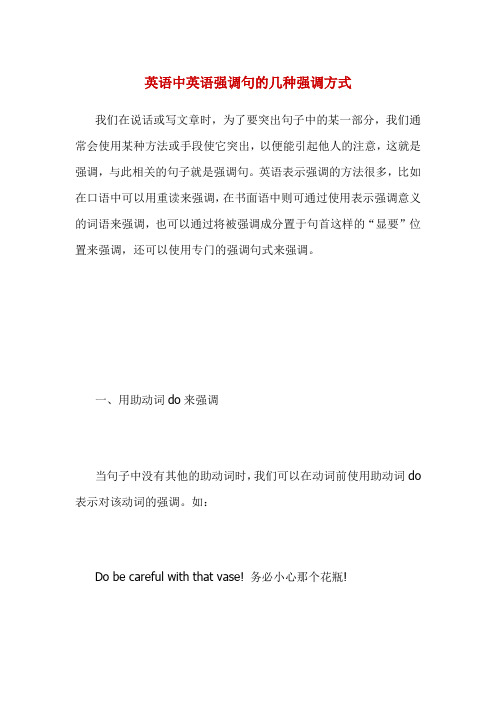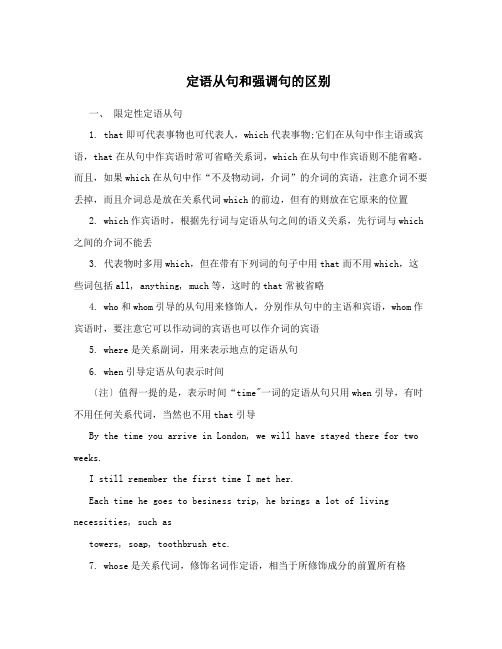定语从句强调句用法
定语从句与强调句型

定语从句与强调句型在英语语法中,定语从句(adjective clause)和强调句型(emphatic construction)是两个重要的语法结构。
它们能够丰富句子的表达方式,并帮助我们更准确地描述事物或进行强调。
本文将介绍定语从句和强调句型的定义、用法和例句,并探讨它们在英语写作中的应用。
一、定语从句定语从句是一个修饰名词或代词的句子,用来对该名词或代词做进一步的描述。
定语从句通常用于限定、说明、或者描述名词,在句中充当定语的角色。
在定语从句中,通常使用关系代词(如who, whom, whose, which)或关系副词(如where, when, why)引导。
定语从句的引导词根据其作用分为三类:1. 人关系代词:who, whom, whose, that2. 物关系代词:which, whose, that3. 地点关系副词:where时间关系副词:when原因关系副词:why下面是一些使用定语从句的例句:1. I have a friend who is a doctor. (定语从句修饰friend)2. The book that I bought is very interesting. (定语从句修饰book)3. This is the house where I was born. (定语从句修饰house)二、强调句型强调句型是用来强调句子中的某个成分,使其在句子中显得更加突出。
强调句型通常使用强调副词(如only, just, even, still, merely)或强调代词(such as myself, himself, herself, themselves)来引导,并将要强调的成分放在句子的开头或结尾。
下面是一些使用强调句型的例句:1. It was John who won the competition. (强调主语John)2. I bought this dress for myself. (强调宾语myself)3. She is such a kind person. (强调形容词kind)三、定语从句和强调句型在写作中的应用定语从句和强调句型在英语写作中具有很高的灵活性,可以丰富句子结构,增加句子的多样性。
各类从句及强调句的结构和用法

各类从句及强调句的结构和用法定语从句:是由关系代词和关系副词引导的从句,其作用是作定语修饰主句的某个成分,定语从句分为限定性和非限定性从句两种。
状语从句分为时间状语从句,结果状语从句,让步状语从句,原因状语从句,条件状语从句以及行为方式状语从句。
名词从句包括主语从句,宾语从句,表语从句和同位语从句及there be 句型。
一、限定性定语从句1. that即可代表事物也可代表人,which代表事物;它们在从句中作主语或宾语,that在从句中作宾语时常可省略关系词,which在从句中作宾语则不能省略。
而且,如果which在从句中作“不及物动词+介词”的介词的宾语,注意介词不要丢掉,而且介词总是放在关系代词which的前边,但有的则放在它原来的位置。
2. which作宾语时,根据先行词与定语从句之间的语义关系,先行词与which之间的介词不能丢3. 代表物时多用which,但在带有下列词的句子中用that而不用which,这些词包括all, anything, much等,这时的that常被省略4. who和whom引导的从句用来修饰人,分别作从句中的主语和宾语,whom作宾语时,要注意它可以作动词的宾语也可以作介词的宾语5. where是关系副词,用来表示地点的定语从句6. when引导定语从句表示时间注意:值得一提的是,表示时间“time"一词的定语从句只用when引导,有时不用任何关系代词,当然也不用that引导By the time you arrive in London, we will have stayed there for two weeks.I still remember the first time I met her.Each time he goes to business trip, he brings a lot of living necessities, suchas towers, soap, toothbrush etc.7. whose是关系代词,修饰名词作定语,相当于所修饰成分的前置所有格8. 当从句的逻辑主语是some, any, no, somebody, anybody, nobody,something, anything, everything或nothing时,常用there is来引导二、非限定性定语从句非限定性定语从句的作用是对所修饰的成分作进一步说明,通常和主句间用逗号隔开,将从句拿掉后其他部分仍可成立1. which引导的非限定性定语从句来说明前面整个句子的情况或主句的某一部分2. 在引导限定性定语从句时,that有时相当于inwhich, at which, for which或at whichAttitudes towards daydreaming are changing in much the same way that (in which)attitudes towards night dreaming have changed.人们对白日做梦的态度正在改变,这与人们对夜间做梦的看法的变化有非常相似之处。
强调句型巧分辨

强调句型巧分辨牛津高二下学期8册Unit4课本同步辅导,针对其中重点句型、重点词汇及重点语法举例详细解释及小练。
1.强调句常与定语从句、名词性从句等混合使用,要注意辨别。
例如:It was in Beihai Parkwhere they made a date for the first timethat the old couple toldus their love story. (强调句与定语从句混合使用)It was at the very beginning that Mr. Smith made a decisionthat we should send for adoctor. (强调句与同位语从句混合使用)Was itwhat we saidor something that we did that made you cry so sadly? (强调句与主语从句混合使用)2.强调句和一些主从复合句结构相似,区分的方法是:如果去掉句中的iti s/was…that/who后,剩余部分在句子结构和意义上仍是统统的,便是强调句,否则就是主从复合句。
例如:It was in the eveningthat he got home yesterday. (强调句)It was eveningwhen he got home yesterday. (状语从句)It was reportedthat he got home very late. (主语从句)It was twenty miles from our city to the villagewhere the accident happened. (定语从句)It is a questionthat needs careful consideration.(定语从句)3.强调句与It + be +时间+从句等易混句型的比较。
①It +is/was +时间状语+that-clause强调句型。
英语中英语强调句的几种强调方式

英语中英语强调句的几种强调方式我们在说话或写文章时,为了要突出句子中的某一部分,我们通常会使用某种方法或手段使它突出,以便能引起他人的注意,这就是强调,与此相关的句子就是强调句。
英语表示强调的方法很多,比如在口语中可以用重读来强调,在书面语中则可通过使用表示强调意义的词语来强调,也可以通过将被强调成分置于句首这样的“显要”位置来强调,还可以使用专门的强调句式来强调。
一、用助动词do来强调当句子中没有其他的助动词时,我们可以在动词前使用助动词do 表示对该动词的强调。
如:Do be careful with that vase! 务必小心那个花瓶!I do hope you'll stay for lunch. 我真的希望你留下吃午饭。
用于表示强调的do可以有时态的变化,但其后的动词要用原形。
如:He does look tired. 他确实显得很疲倦。
He did come but soon went back. 他的确来过,但很快就回去了。
She did write to say thank you. 她的确写信向你道谢了。
注意,这样用的do只用于现在时或过去式(即只有do, does, did 这样的形式),不能用于进行时、完成时等形式(如不用于is doing, has done等)。
二、用某些形容词来强调英语中用于强调的形容词比较多,比如那些表示“极端”和“完全”概念的形容词通常就可以用于表示强调,这类形容词主要的有:mere 仅仅的very 极端的outright 完全的thorough 十足的plain 完全的complete 彻底的pure 完全的perfect 全然的Jim looked a perfect fool. 吉姆看起来像一个十足的傻瓜。
At that very moment the phone rang. 正好在那个时候电话铃响了。
We gave the room a thorough cleaning. 我们把房间彻底打扫了一番。
强调句和定语从句的区别

强调句和定语从句的区别
强调句和定语从句都是英语语法中常见的从句结构,但它们有一些明显的区别。
强调句通常用来强调一个特定的词或短语,以使其更加突出和引人注意。
强调句的结构是:It is/was + 被强调部分 + that/who + 其他部分。
例如:It was John who ate the entire cake. 在这个句
子中,“John”是被强调的部分,强调了他是吃了整个蛋糕的人。
定语从句则用来描述或限制一个名词或代词。
定语从句的结构是:关系代词(that/who/whom/whose)+ 主语 + 谓语 + 其他部分。
例如:The person who called me yesterday was my best friend. 在这个句子中,“who called me yesterday”是定语从句,修饰并限制了“person”的范围,告诉我们是哪个人打电话给了我。
总之,强调句用于强调一个特定的词或短语,而定语从句则用于描述或限制一个名词或代词。
了解它们的区别可以帮助我们更好地理解和运用这两个语法结构。
- 1 -。
定语从句和强调句的区别

定语从句和强调句的区别一、限定性定语从句1. that即可代表事物也可代表人,which代表事物;它们在从句中作主语或宾语,that在从句中作宾语时常可省略关系词,which在从句中作宾语则不能省略。
而且,如果which在从句中作“不及物动词,介词”的介词的宾语,注意介词不要丢掉,而且介词总是放在关系代词which的前边,但有的则放在它原来的位置2. which作宾语时,根据先行词与定语从句之间的语义关系,先行词与which 之间的介词不能丢3. 代表物时多用which,但在带有下列词的句子中用that而不用which,这些词包括all, anything, much等,这时的that常被省略4. who和whom引导的从句用来修饰人,分别作从句中的主语和宾语,whom作宾语时,要注意它可以作动词的宾语也可以作介词的宾语5. where是关系副词,用来表示地点的定语从句6. when引导定语从句表示时间〔注〕值得一提的是,表示时间“time"一词的定语从句只用when引导,有时不用任何关系代词,当然也不用that引导By the time you arrive in London, we will have stayed there for two weeks.I still remember the first time I met her.Each time he goes to besiness trip, he brings a lot of living necessities, such astowers, soap, toothbrush etc.7. whose是关系代词,修饰名词作定语,相当于所修饰成分的前置所有格8. 当从句的逻辑主语是some, any, no, somebody, anybody, nobody, something, anything,everything或nothing时,常用there is来引导二、非限定性定语从句:非限定性定语从句的作用是对所修饰的成分作进一步说明,通常和主句间用逗号隔开,将从句拿掉后其他部分仍可成立1. which引导的非限定性定语从句来说明前面整个句子的情况或主句的某一部分2. 在引导限定性定语从句时,that有时相当于in which, at which, for which或at whichAttitudes towards daydreaming are changing in much the same waythat(in which)attitudes towards night dreaming have changed. 人们对白日做梦的态度正在改变,这与人们对夜间做梦的看法的变化有非常相似之处。
定语从句和强调句的区分方法
定语从句和强调句的区分方法1.结构不同:定语从句是一个从句,通常修饰一个名词或代词,而强调句是一个完整的句子,用来强调一个句子成分。
例句:The book that I bought yesterday is very interesting.(定语从句)It is me who bought the book yesterday.(强调句)2. 位置不同:定语从句通常位于被修饰的名词或代词之后,而强调句则可位于句首、句中或句末,通常用it或者wh-词引导。
例句:The girl who is wearing a red dress is my sister.(定语从句)It is my sister who is wearing a red dress.(强调句)3. 关键词不同:定语从句通常使用关系词(如that, who, which等)引导,而强调句则使用it is...that...或者it is...who...等结构来强调句子的一些成分。
例句:The movie that I watched last night was amazing.(定语从句)It was the movie that I watched last night that was amazing.(强调句)4.强调的程度不同:定语从句主要用来限定名词或代词,使其更具体,而强调句则是为了给一些成分更多的强调和重要性。
例句:I have a friend who can play the guitar very well.(定语从句,强调的是我有一个会弹吉他的朋友)It is my friend who can play the guitar very well.(强调句,强调的是我的朋友会弹吉他)通过注意以上几个特点,可以帮助我们区分定语从句和强调句的语法结构和意义。
高考英语强调句用法总结,必备!
高考英语强调句用法总结,必备!强调句是高中英语学习过程中常见的一种句型,也是英语学习的重点、难点。
强调句是用来表示强调说话人的意愿和情感。
它只是强调句子的某一个成分,通常强调主语、宾语或者是状语。
那么今天小编结合近几年来的高考题,对强调句的基本用法以及考点进行了全面的归纳和总结,希望对大家的学习能有所启发。
一、强调句基本句型1、强调句的陈述句句型为:It is /was+被强调的部分+that/who引导的从句+原句其他部分。
尼们可以看下面例句来体会理解:2、强调句的一般疑问句型:Is / Was +it+被强调的部分+that/ who/ whom引导的从句+原句其他的部分。
3、强调句的特殊疑问句型:特殊疑问词(When /Where/ Why/ Who/ What/ How )+is/ was +it +that从句+原句的其他部分。
二、需要注意的问题1、无论强调据说强调的主语是单数还是复数,强调句中所用的be动词始终都是is或者是was,如果强调的是将来或者是正在发生的事情或正在进行的动作的时候,只能用is;如果强调过去已经完成的就用was。
2、大家需要记住一点,强调句去掉了it is/ was…+that之后,对于句子的完整性不造成影响,这也是与其他句子区分有一个重要标志。
三、考点归纳1、主谓一致。
在强调主语的时候,that后的谓语动词要与被强调者保持是人称和数的一致,例如:It is I who am a teacher.2、连接词。
在强调状语的时候,无论被强调的部分是表示时间还是地点, 能不能用when或者where,连接词只能用that。
同时要注意与下列句型的区分:3、考查对“not…until…”进行强调,常会使用句型“It is / was… not …until…that…”这个强调句型是高考的高频考点,意思是“不是……而是……”。
4、考查与主语从句,状语从句和定语从句的辨析强调句很容易和名词从句这个句型混淆,如:It is clear (obvious, true, possible, certain…) that…大家要清楚这里的it是形式主语,真正的主语是that引导的主语从句。
强调句与定语从句的区别例句
强调句与定语从句的区别例句强调句和定语从句是英语语法中两种常用的修饰句子和名词的结构。
强调句用来强调句子中的某个成分,而定语从句用来修饰名词。
下面是具体的例句,以帮助理解两者之间的区别。
1. 强调句:It was Mary who won the singing competition.(胜利的是玛丽。
)定语从句:The girl who won the singing competition is Mary.(赢得歌唱比赛的女孩是玛丽。
)2. 强调句:It was in the park that I saw him yesterday.(昨天我在公园见到了他。
)定语从句:The man that I saw yesterday was in the park.(我昨天见到的那个人在公园里。
)3. 强调句:It is my brother who is going to travel around the world.(我弟弟要去环游世界。
)定语从句:The person who is going to travel around the world is my brother.(要去环游世界的人是我弟弟。
)4. 强调句:It was at the party that she met her future husband.(她是在聚会上遇到未来的丈夫的。
)定语从句:The man that she met at the party is her future husband.(她在聚会上遇到的那个人是她未来的丈夫。
)5. 强调句:It is the book that I lent you last week.(那本书是我上周借给你的。
)定语从句:The book that I lent you last week is on the table.(我上周借给你的那本书在桌子上。
)6. 强调句:It was on the train that I met my old friend.(我是在火车上遇到了我的老朋友。
强调句型的结构及其用法
强调句型的结构及其用法强调句是一种修辞,是人们为了表达自己的意愿或情感而使用的一种形式,下面简单归纳它的几种结构:一、强调句型的基本结构1.用助动词“do(does/did)+动词原形”来表示强调:He does know the place well.他的确很熟悉这个地方。
Do write to me when you get there.你到那儿后务必给我来信。
2.用形容词very,only,single,such等修饰名词或形容词来加强语气:That’s the very textbook we used last term.这正是我们上学期用过的教材。
ou are the only person here who can speak Chinese.你是这里唯一会讲汉语的人。
Not a single person has been in the shop this morni ng.今天上午这个商店里连一个人都没有。
How dare you buy such expensive jewels?你怎么敢买这么贵的宝石呢?3.用ever,never,very,just等副词和badly,highly,really等带有-l y 的副词来进行强调:Why ever did you do so?你究竟为什么要这么做?He never said a word the whole day.一整天,他一句话也没说。
You’ve got to be very,very careful.你一定得非常、非常小心。
This is just what I wanted.这正是我所要的。
He was badly wounded.他伤得很严重。
I really don't know what to do next.我的确不知道下一步该怎么做。
4.用in the world,on earth,at all等介词短语可以表达更强的语气(常用于疑问句):Where in the world could he be?他到底会在哪儿?What on earth is it?它究竟是什么?Do you know at all?你到底知不知道?5.用感叹句来表示强烈的感情,突出说话人的情感:How interesting a story it is!这是一个多么有趣的故事啊!Oh,what a lie!啊,真是弥天大谎!6.用重复来表示强调:Why!why!The cage is empty!啊!啊!箱子是空的。
- 1、下载文档前请自行甄别文档内容的完整性,平台不提供额外的编辑、内容补充、找答案等附加服务。
- 2、"仅部分预览"的文档,不可在线预览部分如存在完整性等问题,可反馈申请退款(可完整预览的文档不适用该条件!)。
- 3、如文档侵犯您的权益,请联系客服反馈,我们会尽快为您处理(人工客服工作时间:9:00-18:30)。
下面总结强调句型的使用:
一、it强调句型的构成:It+be+被强调部分+that(强调部分指人做主语时时用who,指人做宾语时用whom)+句子的其他部分。
例如:Mary met an old beggar in the street yesterday.
It was Mary who/that met an old beggar in the street yesterday. (强调主语)
It was an old beggar whom/that Mary met in the street yesterday.(强调宾语)
It was yesterday that Mary met an old beggar in the street.(强调时间状语)
It was in the street that Mary met an old beggar yesterday.(强调地点状语)
注意:it强调句型不能强调句子的谓语。
二、not…until结构强调句型的构成:It+be+not+until部分+that+句子的其他部分。
例如:He didn't go to bed until his father came back.. 变为强调句型为:It was not until his father came back that he went to bed.
注意原句中的didn't go部分中的not提前后,剩下did go变为went.
本文开头提到的两个句子都是not..until结构用于强调句型。
那么把这两句话变回正常的语序则为:
1)…but he didn't make his most important discovery until after the war. 2)The importance of Fleming's discovery was not fully recognized until World War II. 三、特殊疑问句强调句型的构成:特殊疑问词+be+it+that+句子的其他部分(用陈述语序) 例如:When did you receive the gift?
对特殊疑问词when做强调:When was it that you received the gift?
注意此句中的received是由did加receive结合而成的。
